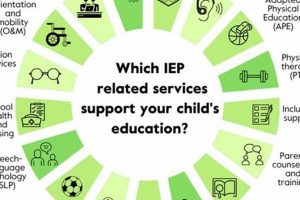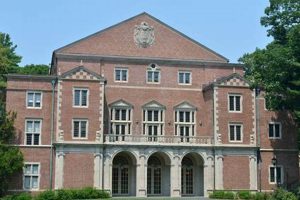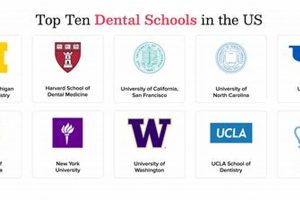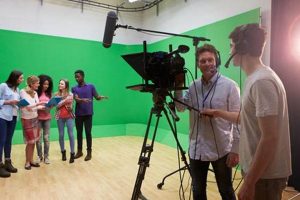Locating residences near high-performing educational institutions is a significant consideration for families in Chicago. This often involves researching academic performance metrics, specialized programs, extracurricular activities, and school community demographics. For instance, a family might prioritize a neighborhood with a strong STEM-focused elementary school and proximity to a reputable high school known for its arts program.
Access to quality education is linked to numerous positive outcomes, including improved academic achievement, increased property values, and stronger community engagement. Historically, certain Chicago neighborhoods have developed reputations for excellent schools, attracting families and contributing to the overall desirability of those areas. This dynamic has played a role in shaping the city’s residential landscape and continues to influence real estate trends.
This article will delve into various factors influencing school selection in Chicago, explore specific neighborhoods known for their educational offerings, and provide resources for further research. Topics covered will include school performance data, diverse program offerings, and community involvement opportunities.
Tips for Selecting a Chicago Neighborhood Based on Schools
Choosing a residence near desirable educational institutions requires careful consideration of several factors. The following tips offer guidance for navigating this process.
Tip 1: Research School Performance Data: Thoroughly examine available performance metrics, including standardized test scores, graduation rates, and student-teacher ratios. Websites like the Illinois State Board of Education and GreatSchools.org offer valuable data and school ratings.
Tip 2: Consider Programmatic Focus: Identify schools offering specialized programs aligned with individual student interests and learning styles. Examples include magnet schools, International Baccalaureate programs, and STEM-focused curricula.
Tip 3: Evaluate Extracurricular Activities: Assess the range of extracurricular activities available, such as sports, arts programs, and academic clubs. These opportunities contribute to well-rounded student development.
Tip 4: Visit Schools and Attend Open Houses: First-hand observation provides valuable insights into school culture, facilities, and teaching styles. Engage with school administrators and current families.
Tip 5: Analyze Neighborhood Demographics: Research the neighborhood’s demographics and community resources, considering factors like safety, access to libraries and parks, and community involvement opportunities.
Tip 6: Factor in Commute Times and Transportation Options: Evaluate daily commute times to and from school, considering traffic patterns and available transportation options. Proximity can significantly impact family schedules.
Tip 7: Consult with Local Real Estate Professionals: Experienced real estate agents specializing in family-friendly neighborhoods can provide valuable insights into school districts and property values.
By carefully considering these factors, families can make informed decisions about selecting a Chicago neighborhood that best meets their educational needs and priorities.
This detailed exploration of school and neighborhood factors provides a comprehensive foundation for making informed residential choices in Chicago.
1. Academic Performance
Academic performance serves as a cornerstone in defining Chicago’s most desirable neighborhoods for families. High achievement levels, reflected in various metrics, often correlate with increased property values and a strong sense of community. Understanding the components contributing to academic success is crucial when evaluating potential neighborhoods.
- Standardized Test Scores:
Standardized tests like the ISAT and SAT provide quantifiable measures of student achievement in core subjects. These scores often serve as benchmarks for comparing schools and districts. Neighborhoods with consistently high test scores often attract families prioritizing academic rigor, contributing to a competitive academic environment.
- Graduation Rates:
Graduation rates reflect a school’s ability to successfully guide students through their academic journey. High graduation rates signify effective teaching, strong student support systems, and a positive learning environment. These rates are closely monitored by prospective residents and often contribute to a neighborhood’s desirability.
- College Acceptance Rates:
The percentage of students accepted into colleges and universities provides further insight into a school’s academic preparation. High college acceptance rates, particularly into selective institutions, can elevate a school’s reputation and contribute to the overall appeal of a neighborhood.
- Curriculum and Instruction:
The quality of curriculum and instruction significantly impacts student achievement. Neighborhoods with schools offering rigorous academic programs, experienced teachers, and innovative teaching methodologies are often highly sought after by families seeking enriching educational opportunities.
These facets of academic performance collectively shape the educational landscape of Chicago neighborhoods. Families seeking high-quality education often prioritize these factors when choosing a place to live, contributing to the dynamic relationship between academic excellence and desirable residential areas. By understanding these components, families can make informed decisions about the best fit for their children’s educational needs and future aspirations.
2. Specialized Programs
The presence of specialized programs significantly contributes to the desirability of certain Chicago neighborhoods. These programs cater to diverse learning styles and interests, enriching the educational experience and attracting families seeking tailored educational opportunities. The availability of such programs often acts as a catalyst for increased property values and heightened community engagement.
Examples of specialized programs include magnet schools focusing on STEM fields, language immersion programs, and arts-integrated curricula. These offerings provide students with unique learning experiences, fostering creativity, critical thinking, and specialized skill development. For instance, a neighborhood with a reputable STEM magnet school might attract families with children demonstrating aptitude in science and mathematics. This concentration of academically driven families can further enhance the school’s reputation and contribute to the overall desirability of the neighborhood. Similarly, a strong dual-language program can draw families valuing bilingualism and cultural diversity, enriching the community fabric.
Understanding the impact of specialized programs on neighborhood dynamics is crucial for families seeking targeted educational experiences. The availability of these programs not only influences individual student success but also shapes the character and appeal of specific Chicago neighborhoods. The presence of such programs often signifies a commitment to educational excellence and a recognition of the diverse needs of the student population, ultimately benefiting both individual students and the broader community. This contributes to the ongoing evolution of Chicago’s educational landscape and reinforces the importance of specialized programs in shaping desirable residential areas.
3. Community Involvement
Strong community involvement plays a crucial role in shaping high-performing school environments within Chicago neighborhoods. Active participation from parents, residents, and local businesses creates a supportive ecosystem that fosters student success and strengthens the overall educational experience. This involvement manifests in various forms, directly impacting school quality and neighborhood appeal.
Parental involvement, through volunteering in classrooms, participating in school governance, and supporting fundraising initiatives, directly contributes to a positive school climate. Local businesses can enhance educational opportunities through mentorship programs, internships, and financial contributions. Community-led initiatives, such as tutoring programs and after-school activities, provide supplemental learning opportunities and strengthen the connection between schools and the broader community. For example, active parent-teacher associations often spearhead fundraising efforts for school improvements, enriching extracurricular activities, and supporting teacher development. These collective efforts create a sense of shared responsibility and contribute to a thriving school environment. In neighborhoods like Beverly and Hyde Park, strong community engagement is evident in local partnerships supporting school libraries, funding arts programs, and providing resources for students in need. These real-world examples demonstrate the tangible impact of community involvement on enriching educational opportunities and creating a supportive learning environment.
The level of community involvement often serves as a key indicator of a neighborhood’s commitment to education. This commitment translates into tangible benefits for students, including enhanced academic performance, increased access to resources, and a stronger sense of community belonging. Recognizing this connection empowers prospective residents to evaluate not only the schools themselves but also the surrounding community’s dedication to educational excellence. This holistic approach to neighborhood selection ensures alignment with family values and priorities, ultimately contributing to a positive and enriching educational experience for children. The symbiotic relationship between community involvement and strong schools reinforces the importance of considering both factors when choosing a Chicago neighborhood.
4. Safety and Resources
Safety and access to enriching resources are paramount considerations for families seeking the best school neighborhoods in Chicago. These factors significantly influence the overall quality of life and contribute to a thriving learning environment. A secure environment allows children to focus on their education, while access to libraries, parks, community centers, and cultural institutions fosters intellectual curiosity and personal growth. This section explores the crucial connection between these elements and desirable school neighborhoods.
- Safe School Routes and Neighborhoods:
Safe passage to and from school is a non-negotiable aspect of a desirable school neighborhood. Factors such as well-maintained sidewalks, adequate street lighting, crossing guards, and low crime rates contribute to a secure environment for children. Neighborhoods prioritizing pedestrian safety and implementing traffic calming measures, such as reduced speed limits and designated school zones, create a more secure environment for students. For instance, communities with active neighborhood watch programs and dedicated police patrols often experience lower crime rates and increased safety for residents, particularly children traveling to and from school.
- Proximity to Libraries and Educational Resources:
Easy access to public libraries provides invaluable educational resources, fostering a love of reading and providing spaces for learning and exploration. Proximity to libraries correlates strongly with academic achievement and offers students supplemental learning opportunities beyond the classroom. Neighborhoods with conveniently located libraries and well-funded library programs provide children with access to a wealth of knowledge and contribute to a culture of lifelong learning. Examples include libraries offering after-school tutoring programs, workshops, and access to digital resources, further enriching the educational experience.
- Availability of Parks and Recreational Facilities:
Access to parks and recreational facilities contributes to the overall well-being of children and families. Green spaces offer opportunities for physical activity, social interaction, and connection with nature, promoting healthy lifestyles and community engagement. Neighborhoods with well-maintained parks, playgrounds, and sports fields provide children with safe spaces for recreation and contribute to a vibrant community atmosphere. For example, communities investing in youth sports programs and offering diverse recreational opportunities foster a sense of belonging and contribute to positive youth development.
- Access to Cultural Institutions and Enrichment Programs:
Proximity to museums, art centers, and cultural institutions expands learning opportunities beyond traditional academic settings. Exposure to arts and culture enriches children’s lives, fostering creativity, critical thinking, and an appreciation for diverse perspectives. Neighborhoods with easy access to these resources offer families opportunities to engage with the broader community and broaden their horizons. Examples include neighborhoods with thriving arts scenes, offering children access to music lessons, theater programs, and museum exhibitions, supplementing their educational experience and contributing to a well-rounded development.
These factors collectively contribute to the creation of thriving learning environments within Chicago’s best school neighborhoods. Families prioritizing safety, access to educational resources, and opportunities for enrichment are more likely to find supportive communities that foster both academic success and overall well-being. By considering these elements alongside school performance, families can make informed decisions that prioritize the holistic development of their children and contribute to their long-term success.
5. Property Values
Property values in Chicago demonstrate a strong correlation with the perceived quality of local schools. Neighborhoods boasting high-performing schools often experience elevated property values, reflecting the premium placed on access to quality education. This connection creates a complex interplay between educational excellence and real estate markets, impacting both homeowners and prospective residents. The desirability of these neighborhoods stems from the perceived long-term benefits associated with strong schools, including increased academic achievement, enhanced college prospects, and a supportive community environment. This, in turn, fuels demand for housing in these areas, driving up property values and creating a competitive real estate market. For example, neighborhoods like Lincoln Park and North Center, known for their top-tier schools, consistently command higher property values compared to areas with lower-performing schools. This price differential reflects the perceived value of access to quality education and its potential impact on future opportunities.
This relationship between school quality and property values has significant implications for both current residents and prospective homebuyers. For homeowners, residing in a desirable school district can lead to increased home equity and a strong return on investment. However, this also translates into higher property taxes, which fund school operations and contribute to the maintenance of high educational standards. For prospective buyers, access to high-performing schools often comes at a premium, requiring a greater financial investment. This can create affordability challenges for some families, potentially exacerbating existing socioeconomic disparities and limiting access to certain neighborhoods. Understanding this dynamic is crucial for making informed decisions about homeownership in Chicago, balancing the desire for quality education with financial considerations and long-term investment goals. The interplay between schools and property values underscores the complex relationship between education and real estate in shaping Chicago’s residential landscape.
The connection between property values and school quality presents both opportunities and challenges within Chicago’s housing market. While high property values reflect the desirability of neighborhoods with strong schools, they also contribute to affordability concerns and potential socioeconomic segregation. Addressing these challenges requires a multifaceted approach, including investment in improving schools across all neighborhoods, exploring innovative housing solutions, and promoting equitable access to quality education. Recognizing the complex interplay between education and real estate is crucial for fostering inclusive communities and ensuring that all residents have access to the opportunities associated with high-performing schools. This understanding empowers individuals, policymakers, and community leaders to make informed decisions that contribute to a more equitable and thriving city. By addressing these complex issues, Chicago can strive towards a future where access to quality education is not solely determined by property values, but rather a shared resource available to all residents, regardless of their socioeconomic background.
Frequently Asked Questions about Chicago School Neighborhoods
This section addresses common inquiries regarding Chicago neighborhoods known for strong educational systems. The information provided aims to offer clarity and guide families through the complexities of school selection and neighborhood considerations.
Question 1: How does one determine the best school neighborhood in Chicago?
Identifying the “best” neighborhood depends on individual family priorities. Factors to consider include academic performance data, specialized program offerings, extracurricular activities, community demographics, safety, and property values. Utilizing resources like the Illinois State Board of Education website and GreatSchools.org can assist in this process.
Question 2: Are high-performing schools exclusive to wealthy neighborhoods?
While some affluent areas are known for excellent schools, several high-performing schools exist in diverse socioeconomic neighborhoods throughout Chicago. Thorough research can reveal excellent educational opportunities across the city.
Question 3: Does living in a top school district guarantee academic success for children?
While a strong school district provides a supportive environment, individual student success depends on various factors, including student motivation, parental involvement, and access to resources. A high-performing school district is one component of a larger equation.
Question 4: How can families navigate the competitive application process for selective enrollment schools?
Selective enrollment schools require careful preparation and adherence to application deadlines. Families should thoroughly research eligibility requirements, gather necessary documentation, and consider attending informational sessions offered by the Chicago Public Schools system.
Question 5: What role do property taxes play in funding schools within a given neighborhood?
Property taxes are a primary funding source for public schools. Neighborhoods with higher property values often generate more tax revenue, which can translate into greater resources for local schools. This connection contributes to the link between property values and school quality.
Question 6: How can one assess the level of community involvement in a prospective school neighborhood?
Attending school board meetings, engaging with local parent-teacher associations, and participating in community events can offer valuable insights into the level of parental and community involvement within a school and its surrounding neighborhood.
Careful consideration of these questions empowers families to navigate the complexities of choosing a Chicago neighborhood based on its schools. Thorough research and a clear understanding of individual priorities are essential for making informed decisions that align with family values and educational goals.
For further information on specific neighborhoods and school performance data, consult local real estate professionals and educational resources provided by the Chicago Public Schools system.
Chicago Best Schools Neighborhoods
Careful consideration of school districts remains a critical component of residential decision-making in Chicago. This exploration has highlighted the multifaceted nature of selecting a neighborhood based on educational opportunities, encompassing academic performance, specialized programs, community involvement, safety considerations, and property value implications. Access to high-quality education significantly impacts individual student trajectories and contributes to the overall well-being of families and communities. The diverse range of educational offerings within Chicago presents families with a spectrum of choices, catering to various learning styles, interests, and priorities.
Strategic planning and thorough research empower families to navigate the complexities of Chicago’s educational landscape. A proactive approach to school selection, coupled with a commitment to community engagement, can pave the way for a rewarding educational experience and contribute to a brighter future for Chicago’s students. The pursuit of educational excellence necessitates continuous evaluation and adaptation to the evolving needs of students and communities. Investing in education strengthens the foundation of Chicago’s neighborhoods and fosters a thriving environment for future generations.







